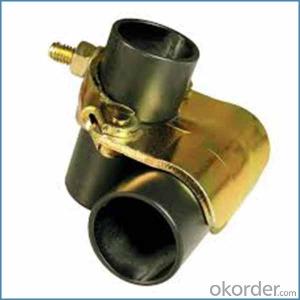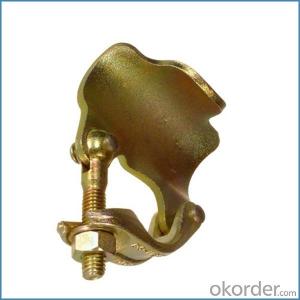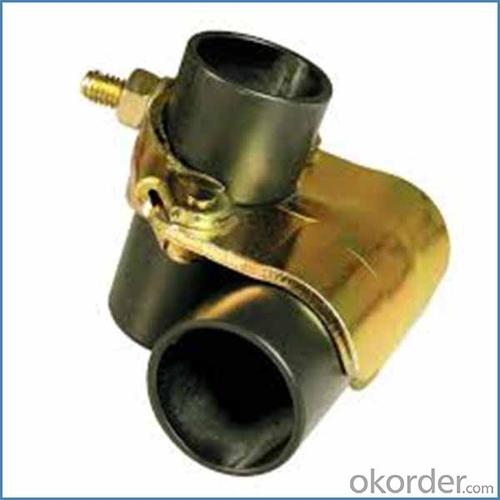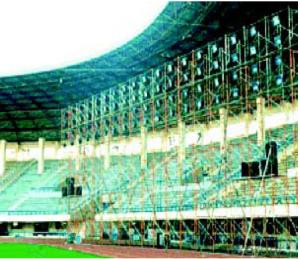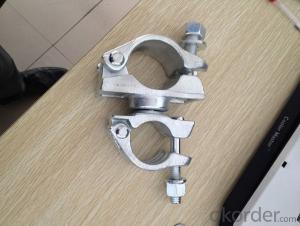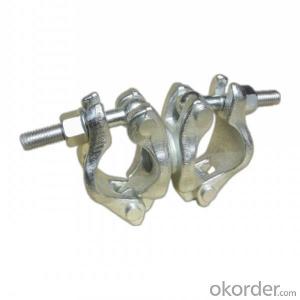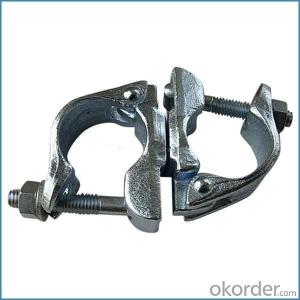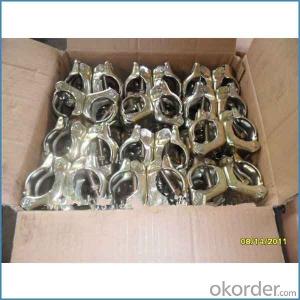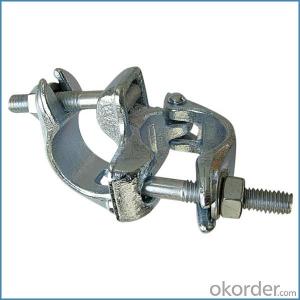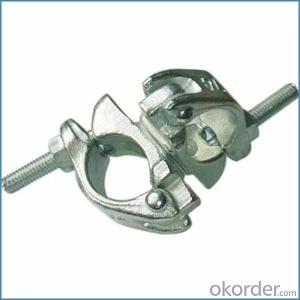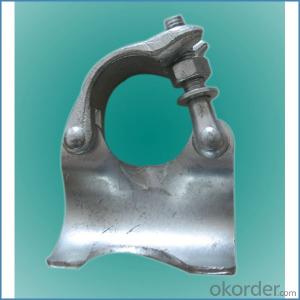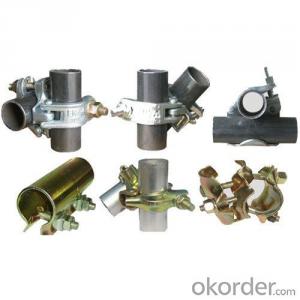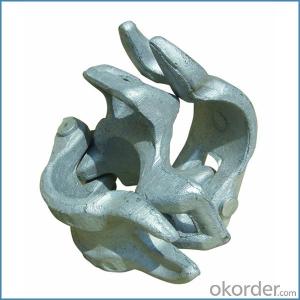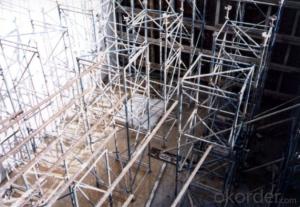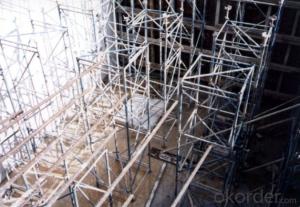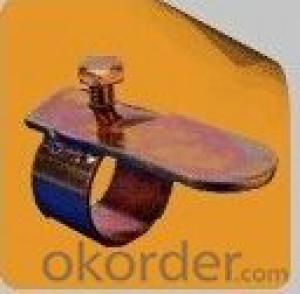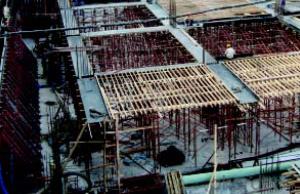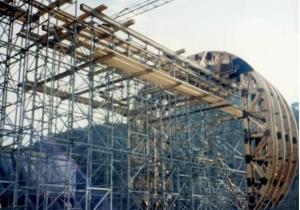Construction Scaffolding Clamps british German Forged Type
- Loading Port:
- Tianjin
- Payment Terms:
- TT OR LC
- Min Order Qty:
- 1000 kg
- Supply Capability:
- 100000 kg/month
OKorder Service Pledge
OKorder Financial Service
You Might Also Like
Construction Scaffolding Clamps british German Forged Type
Description
1.The scaffolding coupler is always used to connect the steel pipe as scaffolding system.
2.The often used coupler is swivel coupler and righ angle coupler .
3.We can provide types of scaffolding coupler according to your requirement.
4.Couoler can fix the 48.3mm scaffolding steel pipe tightly and make the whole scaffolding system more steadily.
Feature
(1)Excellent Anti-Breaking—Cold Pressed Steel
(2)Outstanding Resistance Deformation
(3)Strong Anti-Dropping Ability
Photo
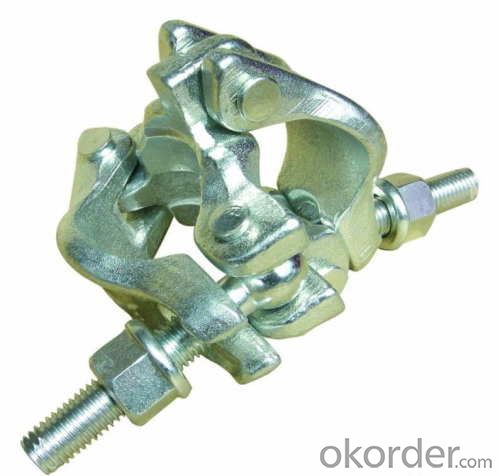
Parameter
| Material | Q235,345steel |
| Size | 48.3mm*48.3mm |
| Surface finish | Galvanized |
| Weight | 1.1kg around |
| Standard | BS1139,EN74 |
| Package | 25pcs/bag,steel pallet |
| Manufacture | As per customer requirement |
| Market | Africa, South America, the Middle East and Asia |
FAQ
Q: Are you a factory or trading company?
We are a state-owned corporation in China,dealing with various kinds of building materials.We have our holding subsidiaries.
Q: Where is your factory located? How can I visit there?
Our factory is located all around China.
Q: Can I get some samples?
Sample is free, customer only pay freight for the first time.
Q: Delivery?
10-30days. (5-15 containers)
Any question,feel free to contact us.
- Q: Can steel tube couplers be used to connect diagonal braces in scaffolding?
- Indeed, it is possible to utilize steel tube couplers for the purpose of connecting diagonal braces in scaffolding. These couplers are regularly employed within the realm of scaffolding construction to effectively link various components, including diagonal braces. By doing so, these couplers establish a sturdy and dependable connection between the tubes, guaranteeing stability and safety in the scaffolding structure. Their design facilitates easy installation and removal, thus enabling flexibility and adaptability within the scaffolding system. All in all, steel tube couplers emerge as a practical and trustworthy solution for connecting diagonal braces in scaffolding.
- Q: How do steel tube couplers ensure proper load distribution and stability in scaffolding structures with irregular or unbalanced loads?
- Steel tube couplers ensure proper load distribution and stability in scaffolding structures with irregular or unbalanced loads by providing a secure and rigid connection between the tubes. These couplers are designed to grip the tubes tightly, ensuring that the load is evenly distributed across the entire structure. This helps to prevent any concentrated stress points and minimizes the risk of structural failure. Additionally, the use of couplers allows for flexibility in adjusting the position and angle of the tubes, enabling scaffolding structures to be built and adapted to accommodate various load configurations.
- Q: Can steel tube couplers be used in scaffolding projects with overhead power lines?
- No, steel tube couplers should not be used in scaffolding projects with overhead power lines as they conduct electricity and pose a significant risk of electrocution. Non-metallic or non-conductive couplers should be used instead to ensure safety.
- Q: What are the common inspection procedures for steel tube couplers?
- The common inspection procedures for steel tube couplers typically involve visual inspection, dimensional measurement, and material testing. Visual inspection is the first step in the inspection process, where the couplers are visually examined for any surface defects such as cracks, burrs, or any other irregularities that could affect their performance. This inspection is essential to ensure that the couplers are in good condition and free from any visible damage. Dimensional measurement is crucial to verify the accuracy of the couplers' dimensions. It involves using various measuring tools like calipers, micrometers, or gauges to check the inner and outer diameters, length, and other critical dimensions specified in the design or industry standards. This inspection ensures that the couplers meet the required specifications and can be properly fitted with the steel tubes. Material testing is another important inspection procedure for steel tube couplers. It involves conducting various tests, such as tensile strength testing, hardness testing, and chemical composition analysis, to ensure that the couplers are made from the correct grade of steel and possess the necessary mechanical properties. These tests help determine the couplers' durability, load-bearing capacity, and resistance to corrosion or other forms of degradation. In addition to these common inspection procedures, other tests or examinations may also be performed based on specific requirements or industry standards. These may include non-destructive testing methods like ultrasonic testing or radiographic examination to detect any hidden defects or internal flaws in the couplers. Overall, the common inspection procedures for steel tube couplers aim to ensure that they are of high quality, meet the required specifications, and are safe and reliable for their intended applications.
- Q: Are steel tube couplers compatible with scaffolding systems that require specialized accessories, such as scaffold hoists or pulleys?
- Yes, steel tube couplers are generally compatible with scaffolding systems that require specialized accessories such as scaffold hoists or pulleys. Steel tube couplers are versatile and can be used to connect various scaffold components, including accessories like hoists or pulleys, making them a suitable choice for such systems.
- Q: How do steel tube couplers provide a secure connection between scaffolding tubes?
- By combining various design elements, steel tube couplers offer a reliable and strong connection for scaffolding tubes. These couplers are specifically engineered to join multiple tubes together, creating a stable and secure link. A significant feature of these couplers lies in their construction, which utilizes top-grade steel. Steel is renowned for its durability and strength, making it an excellent material for scaffolding applications. With the use of steel, the couplers are capable of enduring the heavy loads and stresses frequently encountered in construction projects. In addition, the design of the couplers themselves is crucial. They typically incorporate threaded ends and nuts, enabling effortless and secure tightening of the connection. This threaded design guarantees that the connection remains firm and secure, even in the face of constant vibrations and movements found on construction sites. Moreover, steel tube couplers often include extra safety features such as locking pins or bolts. These mechanisms provide an additional layer of protection, preventing accidental disconnection of the tubes and ensuring the stability of the scaffolding structure. Overall, steel tube couplers are meticulously designed and manufactured to establish a secure connection between scaffolding tubes. With the incorporation of high-quality steel, threaded ends, and supplementary safety elements, these couplers offer a stable and dependable connection that can withstand the demands of construction projects.
- Q: Are steel tube couplers adjustable or fixed in position once installed?
- Steel tube couplers are typically fixed in position once they are installed.
- Q: when i clean it, do i move the bar or not? i just got it 6 days ago so its sill swollen and tight and sore
- Stretching shouldn't injury while you're giving it sufficient time... so this particularly isn't a solid assessment! A single cartilage piercing would not injury plenty better than your usual earlobe (lobe being 2, cartilage piercing being 3 on a scale of a million to ten). yet i've got in no way had a scaffold or orbital of any sort, so i've got not got plenty first hand journey. definitely in spite of the indisputable fact that i would not complication approximately it. it relatively is going to be over in 30 seconds, a million minute tops. and you get to come again away with a enormously new piercing! Yay!
- Q: Can steel tube couplers be used for connecting scaffolding components other than tubes?
- No, steel tube couplers are specifically designed and engineered for connecting scaffolding tubes. They are not intended for use with any other type of scaffolding components or materials. It is crucial to follow the manufacturer's guidelines and use the appropriate couplers for each specific application to ensure the safety and stability of the scaffolding structure.
- Q: Can steel tube couplers be used for scaffolding structures that require frequent modifications?
- Yes, steel tube couplers can indeed be used for scaffolding structures that require frequent modifications. Steel tube couplers are commonly used in scaffolding systems due to their versatility, strength, and ease of use. These couplers enable the connection of steel tubes at various angles and positions, allowing for the creation of customized scaffolding structures to suit specific requirements. One of the advantages of steel tube couplers is their ability to provide a secure and stable connection between steel tubes, ensuring the scaffolding structure remains sturdy and reliable. Moreover, these couplers are designed to be easily adjustable, allowing for quick modifications and alterations to the scaffolding layout as needed. In scaffolding structures that require frequent modifications, such as those in construction or event industries, the ability to adapt and reconfigure the scaffolding quickly is crucial. Steel tube couplers provide a flexible solution that allows for efficient changes to the scaffolding design without compromising its stability or safety. Additionally, steel tube couplers are reusable, which further enhances their suitability for scaffolding structures that require frequent modifications. They can be easily detached and reattached to different steel tubes, eliminating the need for constant replacement or additional materials. Overall, steel tube couplers are an excellent choice for scaffolding structures that need regular adjustments. They provide a strong and secure connection, enable quick modifications, and offer reusability, making them a practical and efficient solution for scaffolding systems requiring frequent changes.
Send your message to us
Construction Scaffolding Clamps british German Forged Type
- Loading Port:
- Tianjin
- Payment Terms:
- TT OR LC
- Min Order Qty:
- 1000 kg
- Supply Capability:
- 100000 kg/month
OKorder Service Pledge
OKorder Financial Service
Similar products
Hot products
Hot Searches
Related keywords
